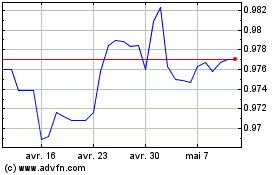Euro Retreats Amid French Election Worries
19 Avril 2017 - 9:17AM
RTTF2
The euro retreated from early highs against its major
counterparts in the European session on Wednesday, as latest polls
showed a tight race between the far-right leader Marine Le Pen and
independent candidate Emmanuel Macron in the first round of French
Presidential election taking place on Sunday.
A poll released by Cevipof for Le Monde newspaper showed that
front runners Le pen and Macron are running neck and neck in the
first round of voting, with 22.5 percent and 23 percent of votes,
respectively. Far-left firebrand Jean-Luc Melenchon scored 19
percent, followed by conservative leader Francois Fillon with 19.5
percent.
The Cevipof poll also showed that Le Pen would lose to Macron in
the second round run-off vote on May 7.
Meanwhile, recent opinion polls showing a surge in support to
Melenchon makes election a four-way contest, with the outcome hard
to predict.
Adding to worries, two men linked to Islamic State have been
arrested on suspicion of planning an "imminent terrorist attack" in
France ahead of the first round of presidential election on
Sunday.
Latest data from Eurostat showed that Eurozone inflation slowed
as estimated initially to a three-month low in March.
The harmonized consumer price index rose 1.5 percent
year-on-year after 2 percent increase in February, which was the
highest since January 2013.
Separate data from Eurostat showed that Eurozone trade surplus
increased more-than-expected in February, as exports rose and
imports fell.
The seasonally adjusted trade surplus climbed to EUR 19.2
billion in February from EUR 15.7 billion in the previous month.
Economists had expected the surplus to rise to EUR 18.5
billion.
The euro showed mixed performance in the Asian session. While
the currency fell against the franc and the dollar, it held steady
against the franc. Against the yen, it was higher.
Pulling away from an early 6-day high of 1.0698 against the
franc, the euro eased to 1.0677. The euro is on track to pierce its
early 2-day low of 1.0673. Continuation of the euro's downtrend may
see it challenging support around the 1.05 zone.
The euro edged down to 1.0708 against the greenback, from near a
3-week high of 1.0737 hit at 3:30 am ET. The next possible support
for the euro-greenback pair is seen around the 1.06 level.
The single currency retreated to 0.8347 against the pound, from
an early high of 0.8374.If the euro extends decline, 0.82 is
possibly seen as its next support level.
Survey by IHS Markit and market research company Ipsos Mori
showed that British households' current financial pressures
intensified in April, as rising inflation and subdued pay growth
have created a renewed squeeze on cash available to spend.
The seasonally adjusted Household Finance Index, of HFI, dropped
42.5 in April from 43.1 in March. This was one of the lowest
readings seen since the summer of 2014.
On the flip side, the euro held firm against the yen, following
an 8-day high of 116.85 hit at 3:10 am ET. The euro is seen finding
resistance around the 118.00 mark.
Looking ahead, the European Central Bank board member Benoit
Coeure speaks at C. Peter McColough Roundtable Series on
International Economics in New York at 9:00 am ET.
European Central Bank board member Peter Praet will give a
speech at the "Levy Economics Institute's 26th annual Hyman P.
Minsky conference" at 10:30 am ET.
At 12:00 pm ET, the Fed releases Beige book report on economic
conditions.
At 1:00 pm ET, the Bank of Canada Senior Deputy Governor Carolyn
Wilkins participates in a panel discussion titled "FinTech and the
Transformation of Financial Services" at the International Monetary
Fund, in Washington DC.
Euro vs CHF (FX:EURCHF)
Graphique Historique de la Devise
De Mar 2024 à Avr 2024

Euro vs CHF (FX:EURCHF)
Graphique Historique de la Devise
De Avr 2023 à Avr 2024
